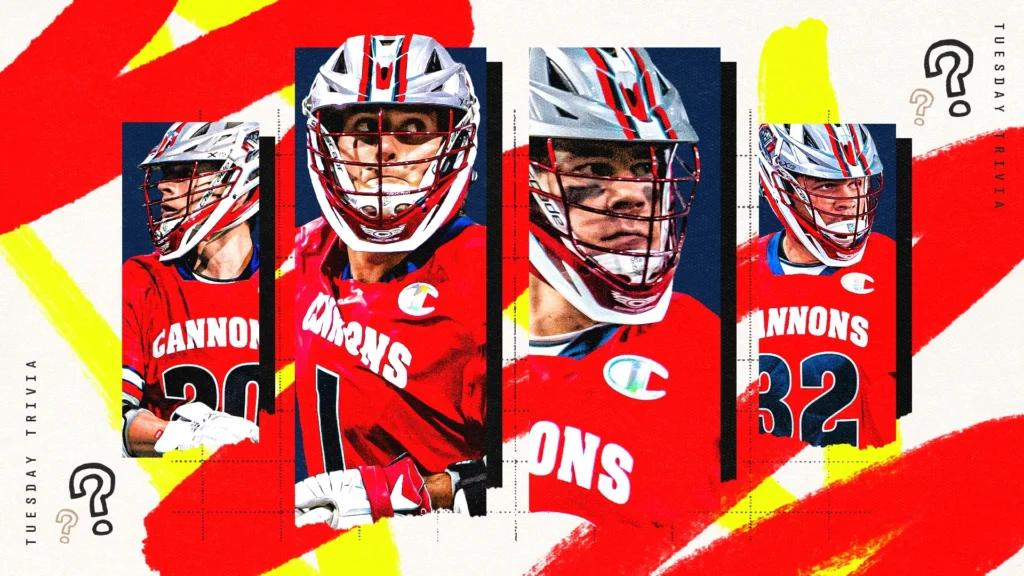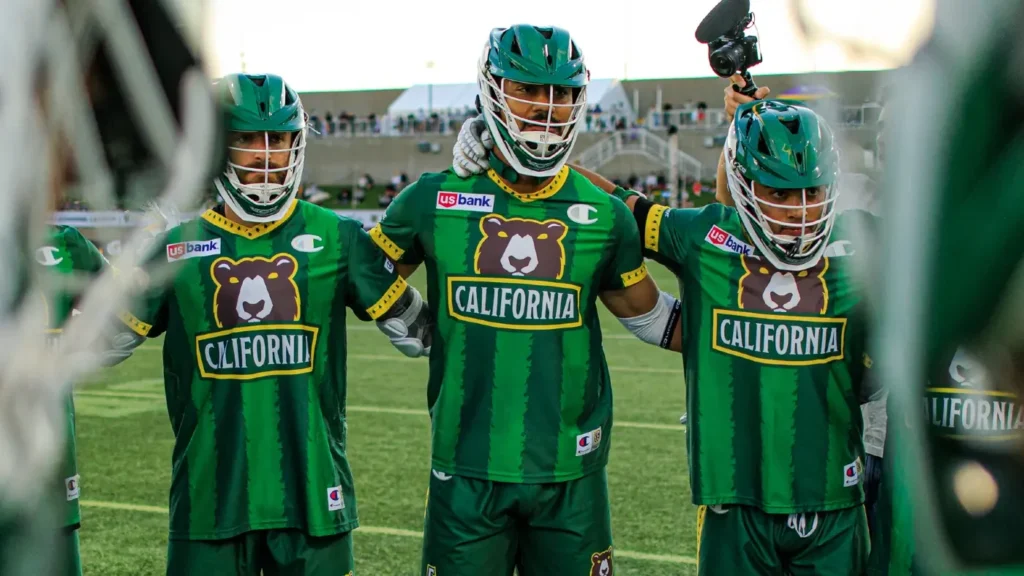
Zach Carey’s final 2025 PLL mock draft
By Zach Carey | May 5, 2025
The 2025 College Draft presented by Q-Collar is coming up quickly, kicking off May 6 at 7 p.m. ET on ESPN+. The league’s general managers are on the precipice of the most significant opportunity to improve their rosters before the 2025 season opens on May 30.
This year’s class might not have the depth of absolute star talent that the 2024 draft had. Yet it’s deep with players who have the talent and experience to have sustained careers in the league. Coaches are confident that there are two, maybe two-and-a-half rounds worth of potential starters in this draft. Teams are likely to draft to their needs now more than ever, and how that dictates which players land where and who falls will be fascinating to watch on Tuesday night.
Nobody really knows what will happen. It’s the PLL draft, after all. Expectations are typically upended quite quickly. With that in mind, here’s how I think the four rounds could play out given each club’s needs and each player’s ideal fit.
No. 1: Philadelphia Waterdogs: CJ Kirst (Attack - Cornell)
Kirst is the alpha of this draft class and projects to have an immediate impact on winning in the PLL. The NCAA’s all-time goals leader can dodge from anywhere on an offense, do damage with both hands and beat defenders in a multitude of ways. He’s mastered every dodge, every angle and every square foot of real estate on a lacrosse field.
The Waterdogs pairing Kirst with Michael Sowers makes for an unfair combination of dodging attackmen. They’ll be a duo that gives defenses nightmares for years to come. The immediate fit alongside Kieran McArdle might be a slight question. But those two should be able to play alongside each other just fine, especially given Kirst’s versatility to attack from anywhere.
No. 2: California Redwoods - Andrew McAdorey (Attack/Midfield - Duke)
McAdorey can shake and bake like few others in professional lacrosse. His ability to separate from defenders purely off his first step sets his floor as a jitterbug dodging out of the box. Whether he can be a go-to guy at the next level will determine his ceiling.
The Blue Devil makes too much sense for the Redwoods and general manager Joe Spallina at No. 2 overall. California needs added offensive firepower, and McAdorey can bring that to the table early as he’ll demand a pole from the jump. Plus, there’s the added component of Spallina coaching McAdorey on the legendary Team 91 club squad back in the day.
No. 3: California Redwoods - Sam English (Midfield - Syracuse)
This is where the draft truly starts. What the Woods do at pick No. 3 will set the stage for the rounds to come. Do they keep the pick and draft perennial winner Chris Kavanagh? Do they pick up a true X attackman in Sam King? Do they surprise and take a non-offensive player?
I have California picking up do-it-all midfielder English with their second consecutive pick. English’s rare ability to play on faceoff wings, take defensive runs and be the short stick on a penalty killl unit boost his ceiling. Yet it’s his straight-line speed on the offensive end that stands out most. Similar to McAdorey, English has the burst and then the high-octane speed to win a matchup across the middle, down the alley or underneath. He’s also a silky smooth feeder and a nifty shooter who can score from low angles.
No. 4: Boston Cannons - Coulter Mackesy (Attack - Princeton)
Boston needs a lefty attackman. After Kirst, Mackesy is the best one in this draft class.
He’s not the dominant individual dodger that Kirst is. Yet he’s an elite shooter from any release point who can create offense coming off a pick. He’s an ideal option to play next to Asher Nolting and Marcus Holman because he doesn’t need the ball to have an impact yet is fully capable of dodging a second or third pole if used correctly.
No. 5: Carolina Chaos - Chris Kavanagh (Attack - Notre Dame)
Kavanagh falling to the Chaos at No. 5 would be a boon for newly appointed general manager Spencer Ford and head coach Roy Colsey. The Carolina offense desperately needs scoring, and Kavanagh can provide that on the righty wing. Kavanagh might not be a true facilitating X attackman. Yet he can still impact winning at a high level if allowed to be a slasher.
The Chaos roster looks bleak beyond its goalie and close defense. There are needs just about everywhere. Kavanagh would be the best available here and would fill a major need on attack for Carolina.
No. 6: New York Atlas - Matt Traynor (Midfield - Penn State)
New York’s roster is as complete as any other in the league. That makes determining who they pick sixth overall a bit difficult. The Atlas could look to add another quality cover defender to their ranks in Brendan Lavelle or Scott Smith. They could merely take the best available player, or even look for options to trade down to pick up future picks.
I have them taking Traynor. While the Atlas’ offense fired on all cylinders for most of 2024, New York’s midfield went quiet for stretches and too heavily relied on its attack to generate offense. In Traynor, the Atlas add someone who can alleviate some of that pressure.
The 6-foot-2, 193-pound Traynor is a versatile offensive piece who can stretch the field, present a target for Jeff Teat and Connor Shellenberger to feed inside and beat a matchup out of the box. His stock has been rising this spring as he’s stepped up for the Nittany Lions, and that could mean he goes in the first round on Tuesday.
No. 7: Maryland Whipsnakes - Levi Verch (LSM - St. Joseph’s)
The Whipsnakes’ biggest need is at short-stick defensive midfield, but I’m not sure if there is a first-round caliber SSDM in this class. Maybe head coach and general manager Jim Stagnitta thinks there is.
My guess is the Whips draft for both value and need, selecting St. Joe’s long-stick midfielder Verch to add to a group of top-tier cover defenders. Verch can be the rabble-rouser of the group on faceoff wings and in the middle of the field, bringing back some of the transition threat that left the club when Michael Ehrhardt retired. He’s not the individual defender Ehrhardt was, but he makes up for it by causing chaos for his opponents.
No. 8: Utah Archers - Scott Smith (Defense - Johns Hopkins)
The defending champs don’t have any glaring holes on their roster. The two spots they’re likely to draft players, though, are at pole and righty midfield. With close defenders Graeme Hossack (32) and Warren Jeffrey (28) on the older end, the Archers are likely to look to add a high-pedigree defender early. The club’s confidence in Mason Woodward to play either close or LSM means Utah can draft the pest long pole available at No. 8.
Smith is my bet to be that guy. The Johns Hopkins defender stands 6-foot-1, 210 pounds. He’s gone under the radar in college lacrosse this year given the Blue Jays’ tough season. But he’s still a menace of an on-ball cover defender with an impressive array of takeaway checks. He can both match feet with quicker attackmen and take shoulders to the chest from bruising dodgers.
I think Smith’s ability to bump up top to guard midfielders and his potential to guard a wider variety of attackmen – including scatbacks like Sowers – will appeal to the Archers. Lavelle is another enticing option should he not go before pick No. 8.
No. 9: Philadelphia Waterdogs - Jake Taylor (Attack - Notre Dame)
The Waterdogs were seventh in the league in shooting percentage (24%) in 2024. What better way to improve that number than by drafting college lacrosse’s most efficient shooter?
Taylor has scored on 53.1% of his shots in 2024, tied for the best mark in the country. The Fighting Irish finisher is an unreal threat on the inside of an offense, as he abuses defenses that don’t stay locked to his hip and can put the ball in the back of the net from any angle at any release point in the blink of an eye.
With Sowers, Kirst, McArdle and Jack Hannah, Philadelphia will have plenty of ball-dominant players on its offense. Taylor can occupy defenders off the ball which should free up space for those initiators. Short term, he can come out of the box. Long term, he could replace McArdle at attack and complete a truly terrifying trio alongside Sowers and Kirst.
No. 10: California Redwoods - Owen Hiltz (Attack - Syracuse)
After taking two players who can win one-versus-one matchups at second and third overall, I’m thinking that the Woods will add a player who can exploit rotating defenders in Hiltz. As the only team that shot worse than the Waterdogs last year, California could use Hiltz’s uncanny touch and precision as a shooter and a passer. Hiltz won’t blow anybody with his athleticism at 5-foot-8, 186 pounds. What he lacks in size and speed, though, he makes up for in craftiness and high lacrosse IQ.
The Redwoods do have Ryder Garnsey, who’s manned the lefty wing for them for years. But I think Hiltz and Garnsey could coexist with Garnsey dodging higher up on the left side while Hiltz mans the lower wing and the crease area. Plus, the reality of the Woods’ regime change is that no spot is guaranteed.
California could also look to pick a goalie at 10th overall after the team finished last in save percentage last summer. Does Spallina believe the top two in this class are worth a top-10 pick?
No. 11: Denver Outlaws - Logan McNaney (Goalie - Maryland)
Who’s the best goalie in this class, McNaney or Emmet Carroll? McNaney has the pedigree as a winner at the college level who’s consistently among the best in the country in save percentage. Carroll has the tools in his body with a pro-ready 6-foot-3 frame compared to the 5-foot-10 McNaney.
Only time will tell which of these two is the better keeper. As far as Tuesday’s draft goes, the Denver defense has strong Maryland ties and could see McNaney as the sort of missing piece that can take the Outlaws’ defense from middle of the pack to among the best in the league.
No. 12: Boston Cannons - Aidan Carroll (Attack/Midfield - Georgetown)
The Cannons drafted a Big East offensive player in the second round in each of the last two seasons, and I’ve got them continuing the trend by picking Carroll 12th overall.
The Georgetown Hoya is a multi-tooled righty who can initiate offense from behind the goal or up top and should profit from short-stick matchups at the next level. He can shoot well from the perimeter and is a cool customer when the lights are brightest.
No. 13: Carolina Chaos - Sam King (Attack - Harvard)
King would almost certainly be the best player on the board should he fall to No. 13. If he does, Carolina should be comfortable doubling down at attack and picking an X attackman to pair with Kavanagh.
King can do everything on offense, dodge from anywhere with either hand, feed from any angle and punish defenses from the outside. He fits the mold of the ideal modern X attackman and could have an instant impact on the Chaos’ offense in his rookie season.
No. 14: New York Atlas - Brendan Lavelle (Defense - Penn)
After considering him when they were on the clock at sixth overall, the Atlas grab a first-round talent in Lavelle at No. 14. The Penn Quaker has garnered much-deserved praise for standout performances against Kirst and Brennan O’Neill over the past two seasons.
Lavelle has the potential to be a true No. 1 cover guy in the PLL, and adding him to a defense that already has Gavin Adler would make New York fans very happy.
No. 15: Philadelphia Waterdogs - Ben Wayer (LSM - Virginia)
Wayer’s stock has taken a tumble this spring, but that could be to his and the Waterdogs’ benefit. Philly could use a natural LSM who can make an impact on faceoff wings, run with midfielders out of the box and create offense in transition. Wayer fits that bill and, at the end of the second round, could be great value for the Dogs despite concerns about his individual defense.
No. 16: Utah Archers - Mic Kelly (Midfield - Denver)
Should this pick play out, the Archers coaching staff would be praising their good fortune that Waterdogs head coach and general manager Bill Tierney didn’t pick his former player Kelly one spot earlier. That’s because the Pioneer midfielder is exactly the sort of right-handed option that Utah could use to fill out its offensive roster.
Kelly is a good step-down shooter who could play as a part of the Archers’ loaded midfield. He should be able to get the mix as a dodger, as well, given his impressive combination of size and speed at 6-foot-2, 210 pounds.
No. 17: Maryland Whipsnakes - Emmet Carroll (Goalie - Penn)
In 2024, the Whips took eventual Rookie of the Year TJ Malone 17th overall. Carroll could be a similar sort of steal at pick No. 17. Brendan Krebs had his moments in 2024 and stepped up in the semifinals with 17 saves. Yet Maryland is still in the market for another goalie following Kyle Bernlohr’s retirement and Will Mark signing with the Atlas.
At the Championship Series, Stagnitta emphasized that Maryland’s goalie position “will work itself out through training camp.”
Carroll has the build and the acrobatic ability to be a good PLL goalie. The question at the next level will be regarding his consistency. On a disappointing Penn team this spring, Carroll registered a below-50% save percentage in five of the Quakers’ 14 games, including two games below 40%. How much of that was a matter of the defense in front of him struggling versus an indictment on his potential as a keeper?
No. 18: Utah Archers - Jack McDonald (LSM - Maryland)
The Archers are not afraid to reach to get the guys they like in the draft. After picking up Smith in the first and Kelly in the second, I see them grabbing McDonald to compete for a spot on the 19-man roster.
McDonald has good size for a prototypical LSM at 6-foot-5, 210 pounds. He’s a good team defender who utilizes his length well to split two guys on the backside. He’s also capable of running with midfielders out of the box with the footwork and playing strength to push guys off their line. McDonald isn’t the transition playmaker that Verch and Wayer are (though he’s far from clumsy with the ball in his stick). That’s just fine for Utah, a team that prioritizes winning in six-on-six on either end of the field.
No. 19: Denver Outlaws - Pace Billings (Defense/LSM - Michigan)
With just their second pick in the draft, the Outlaws should look to add youth and size to their defense. Jesse Bernhardt (34) and Mike Manley (36) are both close to retirement, so beyond JT Giles-Harris and Jake Piseno, Denver’s defense lacks the bounty of youth that the club’s offense has.
A Denver native, Billings could be a good piece to add to that puzzle as a player with close/LSM versatility and the strength to eventually replace Manley as the enforcer on Denver’s back line. He’s a punishing defender who loves hunting caused turnovers and causing havoc in the middle of the field. In 2025, he could fit well alongside Piseno at LSM before making the move to close over time.
No. 20: Maryland Whipsnakes - Ben Ramsey (SSDM - Notre Dame)
Could the Whips really luck out again with a quality player at a position of need falling to them in the third round? They might, because the other teams with needs at SSDM have more glaring holes elsewhere.
Ramsey would be great value at 20th overall. The short stick has been a stud for the Fighting Irish over his four years. He is a heat-seeking missile on crease collapses with the speed to run match feet and the willingness to get physical in his matchups. Ramsey can also spark transition with a knack for breaking upfield once a shot is taken.
No. 21: Carolina Chaos - Joe Juengerkes (SDDM - Rutgers)
If Maryland takes the first SSDM off the board at No. 20, Carolina won’t want to miss out after losing Zach Geddes to the Outlaws in the offseason. Juengerkes would be a good tone-setter to plug into the Chaos’ stout defense. His 4.44 ground balls per game average is first in the country among short sticks, while his 1.0 caused turnover per game mark is fifth among non-long poles.
No. 22: New York Atlas - Hugh Kelleher (Midfield - Cornell)
New York simply doesn’t have many needs. Kelleher is a high-upside option at midfield who can follow in Myles Jones’ footsteps as a physical force out of the box. He’s hardly as polished as Jones was coming out of college. But he can bring real oomph to New York’s offense and could pose a serious two-point threat to feast off feeds from Teat and Shellenberger if given the opportunity.
No. 23: Philadelphia Waterdogs - Jimmy Freehill (Defense - Denver)
The Waterdogs have a lot of young, unproven defenders who will be competing with aging veterans Liam Byrnes, Eli Gobrecht, Ben Randall, Ryland Rees and Chris Sabia in training camp. Freehill can be another dart throw for Tierney and his staff as they eventually look to get younger on defense. Freehill playing for Tierney for two seasons with the Pios certainly shouldn’t hurt his odds of getting picked up.
No. 24: Maryland Whipsnakes - Max Krevsky (Midfield - Yale)
After drafting to defensive needs with their first three picks, the Whipsnakes can add a dynamic midfielder to their roster in Krevsky. He’s a fun offensive prospect who can split left-to-right or right-to-left, give a defender a shoulder and shoot through contact. Krevsky is also accustomed to taking some defensive runs. That likely won’t be what he does in the PLL, but that ability could provide some added comfort for the Maryland coaching staff.
No. 25: Philadelphia Waterdogs - Ryan Cohen (Attack/Midfield - Michigan)
With two elite attackmen and a pair of quality poles in the bag from the first three rounds, the Waterdogs could look to add another highly productive offensive player in the fourth. Cohen is a two-handed player who can be a quarterback behind the cage or jump-start offense from the midfield. He’d be a good invert option in the PLL and could add a bit of speed to Philly’s midfield.
No. 26: Denver Outlaws - Colin Mulshine (Defense - Princeton)
Denver’s offense is stacked with young talent. Its SSDM room is more than solid. Luke Wierman looks like the guy at faceoff and, if the Outlaws take McNaney or Carroll early, then they should keep adding to their collection of poles.
Mulshine is the best available here as a lanky defender who has been battle-tested by four years of Ivy League lacrosse playing against Kirst and King each spring and Mackesy each day in practice. Plus, he played with Billings for three years at Princeton before Billings transferred to Michigan.
No. 27: Denver Outlaws - Alex Marinier (Attack - Ohio State)
Denver has its offensive roster all but set. Adding another strong-shooting midfielder or two to compete for a spot at camp is a luxury the Outlaws can afford.
Marinier could be a steal of the draft. He might not fall this far, but if he does, some team should scoop the big righty Canadian right up. Marinier is a flamethrower, scoring 46 goals so far this season on 43% shooting.
No. 28: Boston Cannons - Jack Gray (SSDM - Duke)
Bubba Fairman is on IR with his return this summer uncertain. Boston could use another body at SSDM in his absence. The Cannons have Zach Goodrich, Pat Aslanian and Jeff Trainor returning and signed TJ Comizio, but they could use another young, high-upside option there.
That’s what Gray is as a proven ACC defender. He’s not flashy as a playmaker in the middle of the field, but he’s a quality on-ball defender who could fit well with an experienced Boston defense.
No. 29: California Redwoods - Mike Grace (LSM - Syracuse)
Grace has been a stock-riser this spring as another player with close/LSM versatility. The lanky lefty is a good organizer of a defense who spent four years at RIT before transferring to Syracuse for the 2025 season. Is mocking three Syracuse players and a former Spallina player to the Woods overdoing it a bit? Maybe, but these are also going to be some of the best guys on the board when the Woods get on the clock
No. 30: New York Atlas - Aidan Mulholland (Midfield - Michigan)
Mulholland is coming off a career year for the Wolverines with 23 goals and eight assists in 14 games. He'd have a lot of guys to beat to earn a gameday roster spot with the Atlas. But he'd be a good pickup for New York to add another high upside young midfielder.
No. 31: California Redwoods - Dylan Hess (SSDM - Florida/Georgetown)
After going all in on offense with their three picks in the first 10 selections, the Redwoods should look to bolster the league’s worst scoring defense from 2024. Cole Kastner – the club’s pick at 32nd overall last year – will help with that. So could Hess, a former Georgetown SSDM who transferred to Florida to play a year of MCLA ball after getting picked 28th by the Chaos last summer.
Injuries to California’s SSDM room necessitate Spallina drafting someone at the position. While he hasn’t played Division I lacrosse in a year, Hess remains a physical specimen at short stick and should have no problem adjusting to the athleticism of the PLL.
No. 32: Utah Archers - Richie LaCalandra (Attack - St. Joseph’s)
LaCalandra is a highlight waiting to happen. The lefty is having a career year for St. Joe’s this spring and could be a nifty pickup for the two-time defending champs at the end of the draft as more lefty depth. He’s a well-balanced attackman who can create for himself and others with impressive speed and a deep bag of finishes and tricks to pull from.





